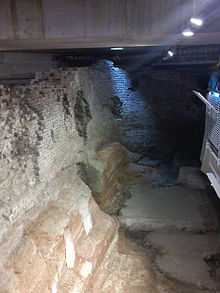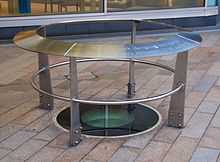Old Dock
The Old Dock, originally known as Thomas Steer's dock, was the world's first commercial wet dock.[1] The dock was built on the River Mersey in Liverpool, England starting in 1709 and completed in 1715. A natural tidal pool off the river Mersey was partially filled and locked in from the river with quay walls erected. The "Pool" gives its name to Liverpool. Thomas Steers was the engineer responsible; additional advice was obtained from George Sorocold.
History

Opening on 31 August 1715,[2] Old Dock accommodated up to 100 ships. Originally a tidal basin accessed directly from the river,[1] from 1737 access was via Canning Dock. The dock was built with one graving dock; a second and third graving dock where added in 1746 and the 1750s.
The dock walls were constructed from brick laid directly on to sandstone bedrock. The dock gates would have allowed as much as 10% of the water out between high tides, resulting in a water level drop of several feet. This may have been offset by water entering the dock from a stream.[3]
Although Liverpool vessels were involved in the slave trade before the dock opened, it would have served ships involved in the Africa-America trade, propelling Liverpool to world leader of this trade. The dock led to Liverpool's establishment as the leading European port and subsequent world trading port.
In the early 19th century, the dock was considered too small for the growing size of shipping using the port; the quays were too narrow; the city's sewage polluted the dock's water; and the narrow wooden drawbridge across its entrance channel caused traffic jams.[1] Sentiment saved the Old Dock for 20 years, but the Old Dock closed on 31 August 1826[2] and was filled in. Liverpool’s fourth Custom House, designed by John Foster, was built on the site between 1828 and 1837, and was demolished after severe bomb damage during World War II.[4]
Redevelopment

In 1999, an office block on the site, Steers House, was demolished, and the resulting waste ground was used as an NCP car park until 2004, when the site was incorporated into the Paradise Project. A water feature has been built on the site of Old Dock to commemorate its history. A portion of the dock wall is exposed in the basement of the new development, and can be viewed from the pavement above through a viewing window in the ground. Tours of the Old Dock are currently operated by National Museums Liverpool on a weekly basis.[5]
Media
The excavation of the dock featured in a Time Team special, broadcast on Channel 4 on Monday 21 April 2008.[3]
Old Dock Sill
The level of the sill of its entrance is used in and around Liverpool as a height datum called Old Dock Sill or ODS.[6][7]
References
- ↑ 1.0 1.1 1.2 "Trading Places: Old Dock History". Liverpool Museums. Retrieved 24 March 2008.
- ↑ 2.0 2.1 "'Liverpool: The docks', A History of the County of Lancaster: Volume 4 (1911), pp. 41-43". British History Online. Retrieved 24 March 2008.
- ↑ 3.0 3.1 "Time Team". Channel 4 Television. Retrieved 22 April 2008.
- ↑ "Customs House". Liverpool John Moores University. Retrieved 8 January 2008.
- ↑ "Info". National Museums Liverpool. Retrieved 21 August 2010.
- ↑ "Liverpool: Home of UK Sea Level Science (A century later – measurements resume)" (PDF). University of Liverpool. Retrieved 5 July 2008.
- ↑ Woodworth, Philip L. (1999). "A Study of Changes in High Water Levels and Tides at Liverpool during the Last Two Hundred and Thirty Years". Proudman Oceanographic Laboratory. pp. 3,77. Report Number 56.
External links
| Wikimedia Commons has media related to Old Dock, Liverpool. |
Coordinates: 53°24′09″N 2°59′19″W / 53.4025°N 2.9886°W
| ||||||||||||||